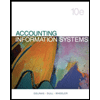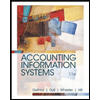The following is a list of 12 control plans from Chapter 8. These are followed by a list of 10 B/AR/CR business process controls or deficiencies. Match the 10 B/AR/CR business process control plans with a pervasive control plan from Chapter 8 that could prevent the deficiencies noted in the preceding list or have an impact on the successful execution of the business process control. Explain the impact that the pervasive control could have. Control Plans from Chapter 8 Access control software (i.e., assignment of access rights to employees) Selection, hiring, and supervision of billing clerks to ensure that they can and do carry out their assigned responsibilities Physical controls for perimeter, building, and computer facilities to prevent loss or destruction of the computer resources Preventive maintenance of computer hardware to ensure reliability and availability Systems development life cycle (SDLC), including testing and approval before implementation of new or revised programs Segregate marketing (i.e., authorization of prices) from billing (i.e., authorization of changes to the billing process and programs) Segregate payment applications clerks from AR clerks who resolve customer complaints Segregate cashier who processes cash receipts from the treasurer Segregate controller functions (recordkeeping for AR) from treasurer functions (custody of cash) Continuous data protection (CDP) to ensure availability of sales order and AR master data Controls for physical and logical access to sales order master data to prevent, for example, unauthorized deletion of open sales orders Controls for physical and logical access to accounts receivable master data to prevent, for example, unauthorized deletion of open invoices B/AR/CR Business Process Control Plans or Deficiencies The treasurer reconciles bank accounts regularly. Monthly statements are printed in the accounts receivable department and mailed to customers. Cash receipts are reviewed to determine that the customer has taken the appropriate discounts. Exceptions are routed via workflow to the supervisor of AR for electronic approval. Sales clerks have been able to approve the taking of unauthorized discounts. Each day, the computer processes the open sales orders to identify those that have been shipped but not yet billed. This list is presented to the billing clerk for action. Occasionally, the billing clerk does not bother to follow up on open sales orders, and invoices are not sent out in a timely manner. Periodically, the billing program identifies open sales orders (shipped but not billed) and prepares and sends invoices. To prevent some invoices from being sent, someone in the organization has changed certain sales orders to indicate that they are closed. When an invoice is prepared, the computer should employ authorized prices, terms, freight, and discounts. Frequent customer complaints include incorrect prices on invoices. Research determines that billing clerks are changing authorized prices prior to billing. Prior to releasing a batch of invoices, the billing clerk compares the batch totals of the shipments to be billed to the totals prepared by the computer at the end of the invoicing process. The computer totals are often incorrect. Upon receipt in the mailroom, checks are forwarded to the cashier and RAs are sent to the cash applications clerks. The computer prepares an aging of open invoices, and accounts receivable clerks follow up on overdue balances. Turnaround documents (e.g., RAs) are used to record customer payments. The scanner often does not read the remittance data correctly.
The following is a list of 12 control plans from Chapter 8. These are followed by a list of 10 B/AR/CR business process controls or deficiencies. Match the 10 B/AR/CR business process control plans with a pervasive control plan from Chapter 8 that could prevent the deficiencies noted in the preceding list or have an impact on the successful execution of the business process control. Explain the impact that the pervasive control could have. Control Plans from Chapter 8 Access control software (i.e., assignment of access rights to employees) Selection, hiring, and supervision of billing clerks to ensure that they can and do carry out their assigned responsibilities Physical controls for perimeter, building, and computer facilities to prevent loss or destruction of the computer resources Preventive maintenance of computer hardware to ensure reliability and availability Systems development life cycle (SDLC), including testing and approval before implementation of new or revised programs Segregate marketing (i.e., authorization of prices) from billing (i.e., authorization of changes to the billing process and programs) Segregate payment applications clerks from AR clerks who resolve customer complaints Segregate cashier who processes cash receipts from the treasurer Segregate controller functions (recordkeeping for AR) from treasurer functions (custody of cash) Continuous data protection (CDP) to ensure availability of sales order and AR master data Controls for physical and logical access to sales order master data to prevent, for example, unauthorized deletion of open sales orders Controls for physical and logical access to accounts receivable master data to prevent, for example, unauthorized deletion of open invoices B/AR/CR Business Process Control Plans or Deficiencies The treasurer reconciles bank accounts regularly. Monthly statements are printed in the accounts receivable department and mailed to customers. Cash receipts are reviewed to determine that the customer has taken the appropriate discounts. Exceptions are routed via workflow to the supervisor of AR for electronic approval. Sales clerks have been able to approve the taking of unauthorized discounts. Each day, the computer processes the open sales orders to identify those that have been shipped but not yet billed. This list is presented to the billing clerk for action. Occasionally, the billing clerk does not bother to follow up on open sales orders, and invoices are not sent out in a timely manner. Periodically, the billing program identifies open sales orders (shipped but not billed) and prepares and sends invoices. To prevent some invoices from being sent, someone in the organization has changed certain sales orders to indicate that they are closed. When an invoice is prepared, the computer should employ authorized prices, terms, freight, and discounts. Frequent customer complaints include incorrect prices on invoices. Research determines that billing clerks are changing authorized prices prior to billing. Prior to releasing a batch of invoices, the billing clerk compares the batch totals of the shipments to be billed to the totals prepared by the computer at the end of the invoicing process. The computer totals are often incorrect. Upon receipt in the mailroom, checks are forwarded to the cashier and RAs are sent to the cash applications clerks. The computer prepares an aging of open invoices, and accounts receivable clerks follow up on overdue balances. Turnaround documents (e.g., RAs) are used to record customer payments. The scanner often does not read the remittance data correctly.
Auditing: A Risk Based-Approach (MindTap Course List)
11th Edition
ISBN:9781337619455
Author:Karla M Johnstone, Audrey A. Gramling, Larry E. Rittenberg
Publisher:Karla M Johnstone, Audrey A. Gramling, Larry E. Rittenberg
Chapter3: Internal Control Over Financial Reporting: Responsibilities Of Management And The External Auditor
Section: Chapter Questions
Problem 7CYBK: What are the components of internal control per COSO’s Internal Control—Integrated Framework? a....
Related questions
Question
The following is a list of 12 control plans from Chapter 8. These are followed by a list of 10 B/AR/CR business process controls or deficiencies. Match the 10 B/AR/CR business process control plans with a pervasive control plan from Chapter 8 that could prevent the deficiencies noted in the preceding list or have an impact on the successful execution of the business process control. Explain the impact that the pervasive control could have.
Control Plans from Chapter 8
- Access control software (i.e., assignment of access rights to employees)
- Selection, hiring, and supervision of billing clerks to ensure that they can and do carry out their assigned responsibilities
- Physical controls for perimeter, building, and computer facilities to prevent loss or destruction of the computer resources
- Preventive maintenance of computer hardware to ensure reliability and availability
- Systems development life cycle (SDLC), including testing and approval before implementation of new or revised programs
- Segregate marketing (i.e., authorization of prices) from billing (i.e., authorization of changes to the billing process and programs)
- Segregate payment applications clerks from AR clerks who resolve customer complaints
- Segregate cashier who processes cash receipts from the treasurer
- Segregate controller functions (recordkeeping for AR) from treasurer functions (custody of cash)
- Continuous data protection (CDP) to ensure availability of sales order and AR master data
- Controls for physical and logical access to sales order master data to prevent, for example, unauthorized deletion of open sales orders
- Controls for physical and logical access to
accounts receivable master data to prevent, for example, unauthorized deletion of open invoices
B/AR/CR Business Process Control Plans or Deficiencies
- The treasurer reconciles bank accounts regularly.
- Monthly statements are printed in the accounts receivable department and mailed to customers.
- Cash receipts are reviewed to determine that the customer has taken the appropriate discounts. Exceptions are routed via workflow to the supervisor of AR for electronic approval. Sales clerks have been able to approve the taking of unauthorized discounts.
- Each day, the computer processes the open sales orders to identify those that have been shipped but not yet billed. This list is presented to the billing clerk for action. Occasionally, the billing clerk does not bother to follow up on open sales orders, and invoices are not sent out in a timely manner.
- Periodically, the billing program identifies open sales orders (shipped but not billed) and prepares and sends invoices. To prevent some invoices from being sent, someone in the organization has changed certain sales orders to indicate that they are closed.
- When an invoice is prepared, the computer should employ authorized prices, terms, freight, and discounts. Frequent customer complaints include incorrect prices on invoices. Research determines that billing clerks are changing authorized prices prior to billing.
- Prior to releasing a batch of invoices, the billing clerk compares the batch totals of the shipments to be billed to the totals prepared by the computer at the end of the invoicing process. The computer totals are often incorrect.
- Upon receipt in the mailroom, checks are forwarded to the cashier and RAs are sent to the cash applications clerks.
- The computer prepares an aging of open invoices, and accounts receivable clerks follow up on overdue balances.
- Turnaround documents (e.g., RAs) are used to record customer payments. The scanner often does not read the remittance data correctly.
Expert Solution
This question has been solved!
Explore an expertly crafted, step-by-step solution for a thorough understanding of key concepts.
Step by step
Solved in 4 steps

Recommended textbooks for you

Auditing: A Risk Based-Approach (MindTap Course L…
Accounting
ISBN:
9781337619455
Author:
Karla M Johnstone, Audrey A. Gramling, Larry E. Rittenberg
Publisher:
Cengage Learning

Pkg Acc Infor Systems MS VISIO CD
Finance
ISBN:
9781133935940
Author:
Ulric J. Gelinas
Publisher:
CENGAGE L

Accounting Information Systems
Accounting
ISBN:
9781337619202
Author:
Hall, James A.
Publisher:
Cengage Learning,

Auditing: A Risk Based-Approach (MindTap Course L…
Accounting
ISBN:
9781337619455
Author:
Karla M Johnstone, Audrey A. Gramling, Larry E. Rittenberg
Publisher:
Cengage Learning

Pkg Acc Infor Systems MS VISIO CD
Finance
ISBN:
9781133935940
Author:
Ulric J. Gelinas
Publisher:
CENGAGE L

Accounting Information Systems
Accounting
ISBN:
9781337619202
Author:
Hall, James A.
Publisher:
Cengage Learning,

Accounting Information Systems
Finance
ISBN:
9781337552127
Author:
Ulric J. Gelinas, Richard B. Dull, Patrick Wheeler, Mary Callahan Hill
Publisher:
Cengage Learning

Business/Professional Ethics Directors/Executives…
Accounting
ISBN:
9781337485913
Author:
BROOKS
Publisher:
Cengage
